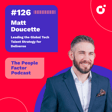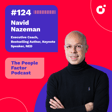Become a Creator today!Start creating today - Share your story with the world!
Start for free
00:00:00
00:00:01

#104 - Jessie Schofer | CEO & Co-Founder of Stakkd
Jessie Schofer is the Founder of Stakkd, the go to place to discover HR tech. She is a strategic leader with 13+ years of unique experience in both corporates and startups. Jessie is known for her unconventional approach to People topics and is passionate about HR tech and leveraging the benefits to build the future of work.
Shownotes
00:00 - Intro & Context
03:15 - Finding the Right HR Tech Stack: What Really Matters?
13:00 - Differences in HR Tech Strategies: Startups vs. Scale-ups vs. Corporates
23:00 - Trends and Tools: What's Hot in the HR Tech Space?
Links
Guest Linkedin:
Thomas Linkedin: https://www.linkedin.com/in/thomas-kohler-pplwise/
Thomas e-mail: thomas@pplwise.com
pplwise: https://pplwise.com/
Transcript
Introduction to Jesse Schofer and Stacked
00:00:00
Speaker
Today's guest, Jesse Schofer, CEO and founder of Stacked.
00:00:07
Speaker
Jesse and I have already worked like this together. I worked at here and tax fix, and we did a lot of head company together. I remember it was really a long night and a lot of back and forth. And then we also built very sophisticated sheets, but we never had a tool. And
Motivation Behind Stacked
00:00:23
Speaker
I think these were also some moments where Jesse always felt like she needs to build a tool. And now she went down that road and built a stack.
00:00:32
Speaker
um platform where you can just evaluate and find um HR tech or tele-negligation tech technologies. And we talked about what to look for in terms of your HR people text tech stack. What are the most common patterns? What are some best practices in evaluate and implement a tool and get the decision um signed off?
00:00:55
Speaker
so That's something what I think can be very useful now when budgets are signed off or being signed off. Plus, you always want to know how to do procurement in your function because I think it's getting way more complex and have and and everybody has way more options. so That's the um number one episode for you when choosing HR tech.
00:01:19
Speaker
Finally, we made it, Jesse. We know each other now for, I think, three years. I've always talked about doing the podcast, and now now we are here, and I'm very curious about what's going on at the moment. and But maybe we start with a short um intro about yourself. Give us some context on who Jesse is. Thanks, Thomas. I'm excited to be here, too. um Yeah, we finally made it. um so About me, I recently decided to venture into starting Stacked. I've become a founder in March this year. and Stacked, if you don't know it, is a HR tech database where it helps professionals find HR tech and kind of discover the market, which is just completely you know flooded. there's There's a lot of tech out there, so we're trying to make it easier to navigate that.
00:02:05
Speaker
um And previously to that, I was in, you know, unicorns, worked with you a few times in some unicorn scaling, people, ah functions, working in the strategy of people, space and also.
00:02:17
Speaker
you know, prior to that was in Australia. So I'm now in Germany. There's, there's lots I could say, but I'll leave it at that. Yes.
Challenges in HR Tech Selection
00:02:24
Speaker
Um, and nowadays I think people have, or people teams have a lot of choices regarding choosing the right tech stack in the HR talent acquisition space. So what patterns do you see most when people reaching out to you regarding, um, choosing the right tech stack?
00:02:44
Speaker
That's a good question. I think what I'm seeing is a common theme across when people are reaching out or when I'm, you know, seeing people also online and in communities asking questions. There's usually the same question. It's what is the best tech, right? And, you know, they ask that question with a, bit and you know, you think, okay, that's an easy question. Is it? No, not really. It's actually a very complex question to answer. And that's why it is hard to get the right tech for business.
00:03:07
Speaker
um And, you know, you see people on LinkedIn asking the entire LinkedIn audience, you know, what's the best tech without any context? um And it's like I relate, you know, finding tech to very, very similar to finding the right candidate for your business. So being in talent acquisition space, you know, you know you don't just ask someone who's the best candidate without any context. You know, you've got to give them context. who What kind of person are you looking for? What kind of role is it? What does the business need? What is the business strategy that this person is going to work towards?
00:03:35
Speaker
And then you can start to narrow down who or what might suit that um that criteria. And it's the same with heck You know, you need to understand that more broadly. So we're seeing that kind of trend where people are just asking the question out there. And I think it's because it is a complex topic um and it is hard to find tech and what is
Tech Needs Across Business Stages
00:03:55
Speaker
out there. And that's why we created Stacked. Because when I'm having conversations, people are going, oh, do you know a tool that does this? Do you know a tool that does that? It's like, let's just put everything in one place and make it easy to search and find things that could solve your problems.
00:04:09
Speaker
and And do you also see certain tech stacks around startups versus scale-ups versus corporates? Yeah, I think of course the smaller companies with maybe less funding are a lot more cost-conscious. They're looking for those either. They're looking for tools that are you know very um Either they're kind of all in one, so they just have to have one platform that's sometimes cheaper when they don't need a lot of additions and they just have the basics um sometimes. Or they're looking for you know your very specific point solution that's very cost-effective. They're looking for things that are maybe add-ons to Slack or um other tooling that is maybe just purchasing a once-off, so you can also get now you know performance management
00:04:54
Speaker
tooling for very small businesses that you just pay just for that performance round to have access. you know so there There is definitely a difference between that early market where they're looking for you know that cost-conscious, low infrastructure, low effort to implement kind of tooling. Then you have your businesses that are you know kind of either established or becoming more established, you know maybe looking they're coming into this growth phase and they're looking for a very um deep deeper infrastructure. so They need the stuff that you know integrates together. They need um the tools that are going to serve them for the future of work and the future strategy that they have. um They're willing to spend a bit more money, um but there is still still what I see is a lack of understanding of what the business needs as a first point.
00:05:40
Speaker
um And I think that's where everything kind of falls over. You can't get the right tech if you don't know what you're looking for. Same with candidate selection. Can't get the right candidate if you don't know what job they're going to fill or what role they're going to do.
00:05:52
Speaker
Yes. And what I see most and in terms of transition is that a lot of ATSs or turn acquisition tech stacks are switching to HPE because I think the advantage what I see there is that you also have scheduling and the very structure a very good reporting function in one plus you have a lot of um functionalities like a CRM system where you maybe previously would need to have two or three tools to do that. um So that's a movement what I see is very popular and what I i also think totally makes sense. We're just one provider started really
00:06:26
Speaker
um but breaking the boundaries of what ATS did in the past i and also met the founders. um And they're both two engineers who just wanted to build the best products out there for recruiting, which I think you you can see. On the HR side, do you see tools that are mostly commonly used at the moment or trendy?
00:06:52
Speaker
I mean, yes, but it depends on, again, size and it depends on the region of the world you're in. um I would say, of course, the big names you always hear are like, I'm high Bob. It's very trending. A lot of companies are switching to high Bob because they've had, you know, they're, they're growing businesses and they're trying to swap. That's usually the people I'm talking to that are going through that change phase. um And there's tooling, you know, just as good though, like chart hop.
00:07:17
Speaker
there's tooling that does different things in you know different regions of the world. So I think it's very hard to say what is the best or trending. I think it's more very, it's very contextualized to the area. um And you know you have actually a company called Humans is something that I start seeing more and more um people are considering their UK based HRIS kind of um tool. And yeah, they're coming up quite a lot more, I think, because they're also doing it a little bit differently.
00:07:43
Speaker
Yeah, so I mean, there's a lot there's a lot in that space. um Again, contexture can context to business is the most important thing, I think. And maybe on the um the Ashby point, I have heard that quite quite a lot, um that people are swapping to Ashby. What I'm also seeing, though, in that ATS category is a lot of the kind of point solutions that were really good at you know interviewing or other parts of that journey are now becoming you know, the all in ones as well, the all in one ATS like screen loop, for instance, you may have known was um just doing this interview space and now they've moved into all in one and they offer very similar, you know, all in one kind of space um ATS category.
00:08:22
Speaker
um And you have, you know, so there's there's definitely movement in that space. And I think although Ashby, you know, I've heard a lot of good things about them, there's lots of established businesses doing really well in that space. And there's also a lot of new players, I think, going to come in, especially all the AI tools that have started very like point solution. And now they're adding to that very, very quickly. So I think, you know, people should definitely um check out what's there and and see what can suit their business. What's the most trendy category you see bumping up?
00:08:50
Speaker
A training category is definitely um anything to do with skills-based. So skills-based hiring, skills-based talent management, um really understanding the workforce skills and the growth pathways um for development reasons, um for the business need, but also for the you know enabling that career progression ah more clearly. And of course, the sourcing space, because it's one of the things that's the most easy to use AI for. you know you can AI is great at going out and taking a lot of data and bring it back in and analyzing it much, much faster than humans can do. That space is definitely growing um very quickly. um and Of course, the space where it's like note-taking or you know reducing this kind of admin for recruiters is also becoming quite big. I've seen a lot of plays in that space. Or companies like um that are bigger adding these kinds of features to their products.
00:09:42
Speaker
What is the most common use case where you still see Google spreadsheets or Excel being the top solution or tech infrastructure? I mean, I think you can guess this one. Well, there's two, two of the biggest use cases for that are one is headcount planning and one is compensation. So I think compensation is the one that everyone would think of and pick. Um, it's very, very underdone. Um, there's lots of companies that still don't have even don't have, don't use benchmarking data, don't use a tool to manage the review rounds or do the analysis, which is just, in my opinion, in this day and age, it it just doesn't make sense. like Your team needs tooling to be the best and um work the most efficiently, and to have you know proper market data makes a lot of sense, especially with all the pay gap issues. and I've been there. seen I've seen this the bends that people have in businesses when they don't use market data, and I think
00:10:33
Speaker
you know is something really easy to get onto. So definitely compensation and then the headcount side, headcount planning, that's becoming more and more of a topic that the people team has to look after. So um that's becoming a lot more um digitized, I would say, there is a lot of tooling that's coming up in that space to get people out of sheets. Like no one wants to do scenario planning in sheets and make 4,000 changes to their formulas. And there's all the errors that come with that. So I think that's somewhere that everyone could benefit from having a tool. Having gone through a number of times. yes i think yeah I think the most most intense time we had together was working on headcom planning for um a lot of cycles and and iterations going back and forth.
Structured HR Tech Selection Process
00:11:18
Speaker
Yeah. Very many times in more than one business, um you know planning, and it does take so much time, the amount of time wasted in those sheets and coordinating through that and the data errors and all the things you have to like clean up, it's just amazing that business haven't yet discovered that they can really save time with tech, especially these Cobb tech and headcount planning tech.
00:11:43
Speaker
and um When you are now in the shoes of somebody in talent acquisition or HR, what could you recommend as a way of finding the right tech stack? So do you have a process where you see, okay, this is actually the steps you should follow that you really do it professionally?
00:12:05
Speaker
Yeah, I mean, ah so there's actually a profession for this. It's called procurement. you know And what what's funny is that HR and TA professionals are now having to be procurement managers. um And so there is tried and true methods. There is a structure to how to you know procure something into the business to buy something. And you know learning those key steps will be very, very helpful to everyone who is in these professions because it will be more and more needed in the future. so i mean the The clear steps are you know you need to understand the business strategy, you need to have you know your projects set up, you need to have assessment criteria, the must-haves. You need to know what you're going to ask in terms of you know questions and you need to know who your stakeholders are in the business who are going to say yes or no. There's there's a lot of steps that need – I mean a lot, but easy to execute steps. and
00:12:57
Speaker
They're actually very, very similar to the recruitment process. like Everything you do to hire a candidate, you can almost mirror and copy-paste and do exactly those steps and contextualize it to a HR tech project. you know um And we actually have some templates that we built for this because no one has time. Like no one's ever got time for any of this stuff. That's why we skip steps because we're just under the pump. So what we try to do is make it just easier and provide, you know, templates for project um hubs and scheduling, you know, how do you get out your project schedule? Okay. We've got a template for that. How do you ask demo questions? What demo questions? We've got a list of questions to ask. We have a template for the assessment matrix so you can pop everything in.
00:13:38
Speaker
and a return on investment calculator so you can get your business case going. And we have a business case template. So we have lots of templates and guides to help um you know professionals try to do this in a faster, more professional way um without having to yeah take all that time. um So yeah, they can check it out at our resource hub. um But yeah, there's definitely procurement. And then if you add onto that, project management and change management are very critical for doing for doing you know these projects properly.
00:14:05
Speaker
It just was an event last week in Munich with some private equity folks that are looking into HR tech and WorkTech. And then there were some discussions and what I um mentioned and found is that most of the HR executives that maybe want to push for more budget on um technology or any other thing they want to implement, they struggle.
00:14:34
Speaker
maybe the most in the executive function in raising budget internally. This is what I just saw from a perception perspective outside. um So I think that you really need to also nail the business case, as you mentioned, you you just need to be aware that this is actually something that you should build plus you should also get some other executive sponsors on your side that can contribute and help. I think for talent acquisition, this can be quite simple because usually talent acquisition budget gets freed up when some function um needs to reach certain targets.
00:15:14
Speaker
yeah um and then they don't get the amount of TA resources or capabilities in order to get the highest done or the right people. um into the team. yeah And then also, for instance, if it's in sales or tech, the CTO or CRO would also say, okay, then I free up some budget or take my budget because I have it left because I don't have the teams ready. So I don't use the budget, please use it. These are often the cases how I see talent acquisition services and being bought way more easily than a technology solution. And doesn't need a jar because I think the direct impact is quite
00:15:55
Speaker
Is it clearer or is it easier to to see maybe? um Do you have frameworks for calculating an ROE or for getting executive sponsors internally to also just back up your decision or your proposal?
00:16:10
Speaker
I
Aligning Tech with Business Strategy
00:16:11
Speaker
think this is where you know people say, you know I went through this process. I've got this tech. I want to buy it. They're trying to get people on board. They've got a business case even sometimes, even an ah ROI calculation. But what they haven't done is made sure the business needs that tool right now more than anything else.
00:16:26
Speaker
So investments always about what this finite money, where should the money go? Where should the resources go? um And I think that's where having your people strategy and your roadmap planned, looking at here's the business strategy. Here's what we need in order to deliver that over the next 12 to 18 months.
00:16:44
Speaker
You've got a technology roadmap. You've thought about, this is the tech we have. Here's the tech we would like to consider getting. Here's what we need to do in the whole people team. Here's our roadmap. This is how we plan our budgets. People have already heard about this tooling and infrastructure need before you've actually brought them the tool that you need.
00:17:03
Speaker
so i think a lot of the time, you know people go to a conference, they see a tool, they're like, oh, this is great. They you know they have all the calls. They don't involve anyone. They come back and they're like, we need this tool. It's great. you know We've even got a discount. And they're going, yeah, but that's not the most important thing we can do with our money for the business right now. It's not part of our strategy, or it could be, but we've got to spend money on other things first. So having that discussion upfront, having a people strategy and a roadmap that includes your technology roadmap is the first step. Because that transparency of what has to be delivered to enable the business strategy. so If that means you know investing in a HR tech tool or recruitment tech, that means that the business know about that. so They're going to be like, okay, cool. We know that that's coming. We know when they bring that to us that it's already thought through. We know it matches what we need. so I think that's the first step that everyone misses is actually really thinking through what your team is working on and why they need this tech and why they need it now. and Why does the business need this tech? Because, of course, there's always a business case for HR to have tech. um It's why does the business need this tech right then?
00:18:01
Speaker
So I think that steps missed. And then of course, the ah ROI calculation, the business case, once you get to actually getting approval, bring your stakeholders on early. Like you said, have an executive sponsor. There's lots of things that can make your life a lot easier. And most of it is just building relationships, being transparent and talking about things with people before you need their approval. um And of course, then you have the numbers, everyone likes data.
00:18:25
Speaker
do your calculations, we've got a template online, um do your business case, we've got that as well. um And then you should see a lot better success. Do you have an example for a category how you would um model the the mechanic of the ROI calculator because this can look very, very different, right? For instance, in Internet acquisition is also quite simple for sales, but maybe not so easy and easy for a technology hire or a general and admin i hire, for instance, then you need to find um a certain um storyline that is also make sense, right? So I always wonder how would you do that with um the variety of HR tech categories?
00:19:09
Speaker
in terms of how you would justify the spend on it. yes I mean, to justify the spend, you need to look out what you're spending to do this. But let's say let's say let's choose a category on your website. Let's say, for instance, for a career path tool or for a
00:19:27
Speaker
Yeah, let's say a career buff tool, because I think that's that's not so easy, right? Or also maybe even a benefits tool or an employee experience tool. Okay, so let's go with benefits. That's a good use case, benefits. Everyone's kind of had that discussion of if we need new benefits, how are we going to do this? Anything?
00:19:41
Speaker
you know You look at your program and you go, all right, there's actually some tech platforms out there to enable this to be better, faster, easier. And the you know the people team go away and there's amazing you know plan with this tech that's going to enable all these you know benefits to the business. They're personalized and great. And then you're like, no, we don't get you didn't get approval. It's because usually they didn't highlight how much um return on investment they're going to get for this. So to do that, you would look at calculating what is the cost to enable benefits now, so that the now existing case, that is what people, what technology, what cost, administration, you know it's not just people team, it's also finance team, it's also tax advice, it's all the things that go into A to Z benefits in the business, capturing all of that cost.
00:20:26
Speaker
And then having a look at, okay, if you were to go option one, we do it with this tech system. How much would it cost to run and administer this over a period of time? How much would it cost to like get the tech and set it up? um How much would the benefits themselves cost through this, et cetera? So you get all the costs related to your um you know your new case. so the case you want approved. um And then usually, I like to have a third option, because there's always do nothing, which is keep things as it is. There's always your preferred option, which is the one you think is the best. And then you can also have a third option, which is um what is maybe less, maybe not not as much tech, you revamp the program, um you still have to do manual work, but it's a better option for um than what you've got now, right? So maybe not the 100% perfect case that you want, but there's an alternative to
00:21:16
Speaker
0 to 100. So I always calculate all three, and then I give them the risk or the impact of not choosing that. so you calculate that out, and then you bring that into a contextualized storyline. And then it's very much easy for someone to say, and you give them an options paper. I don't know if anyone's heard of an options paper, but I wrote them a law in government. Basically, you say, here's what we've done. Here's the recommendation. You have your options now. Someone has to make your decision. right You don't just go there and be like, hey, will you approve my budget? You go, here's a paper. Here's the business case. Here's all the numbers.
00:21:50
Speaker
Option one, do nothing. Option two, recommend it because of these reasons, and you've got all the data there. Option three, 50% outcome still benefits, but not as good as the other one. And they all have the costs already there because you've done the return on investment calculation. That's how you get. So you make it also easy to decide, right, for them? Yeah, make it easy. like Decision makers make so many decisions a day. Make it so easy that they're like- And they should not have more questions when you come for a proposal, right? Or any questions, actually.
00:22:17
Speaker
No, and you know maybe there's some clarifying things, but more or less, you should make it so easy that they're like, yeah, okay, that's silly not to do that. that I get that for my business. and This makes sense. We're saving money on the team. We're going to have better outcomes, reduced ad. you know Not as many people needed to be hired when you scale. ah you know those things Capturing those things, like right now, it's cheaper to do it manually. In the future, when you have more people,
00:22:42
Speaker
It's not necessarily going to be cheaper because you'll need more people in the team, in the benefits team or the admin team to do all the admin manual work. So as you scale, it becomes messy. So right now it might cost you less, but if you get the tech, when you scale, you're not scaling people. So the tech can take all that effort away.
00:22:59
Speaker
That's where you can show return on investment that right now it might cost you money, but in you know two, three, four years from now, you're going to be way ahead in terms of cost. so That's why you know planning out not just this year and the next year, but a couple of years in advance um and projecting that savings can really give the business case, especially for growing businesses. so For instance, for the benefits case, a very simple tagline could be instead of hiring more HR admin or but benefits compensation manager positions, you could just add a tool and then you maybe need way less headcount that you save on personal cost, for instance.
00:23:36
Speaker
Yeah, and it's not just um not even just in people team. It would be in finance team. Because finance usually has to process benefits into payroll. um no so there's yeah That's exactly right. that's That's where you can start to show benefit. And if you can articulate that um into the decision makers you know papers so they can make they can just be like, that's that's so easy. like I would be like, yep, cool. Done.
00:23:58
Speaker
i Because this is actually what what most people don't understand, how how decisions are sometimes being done right with like this conversational approach. the If you do that, you save that. And then, of course, you can come with exact numbers and calculations, but this is often just really relevant if there are questions. How much? But what's the um the assumption behind it and so on? Then you can easily show it, but usually these details are not even necessary. right No. lead with Lead with simplicity. That's why often paper is so good. Summary, recommendation, options, decision comes out of it. If they want the data, it's all sitting there. um You should know the data. you know It should be like, I understand, you know you should be able to reference it. You should be able to find it easily.
00:24:44
Speaker
And if you can't find it and reference it easily in your own documentation or remember it or understand what you've written, chances are no one else will. So, you know, just making things simple as well. um well What are the most crowded categories on your database?
Overview of HR Tech Categories
00:24:58
Speaker
I see probably compensation candidate assessment and interviewing. Yep, candidate assessment. Also ATF, HRAS or core HR, you know, these core HR, whether you're either core or they've got additional kind of all in one module kind of packages.
00:25:13
Speaker
um Sourcing, like I spoke about before, compensation, definitely. um ah these Yeah, these skill-based talent intelligence kind of space where you're not really sure what the category is. we're We're looking at our categories right now because there are just so many tools that cover so many categories and we are trying- Sourcing is also really crowded. Yeah, exactly. Yeah. We're very crowded. um So we are trying to keep the categories um products in one category, though they can serve multiple things. and We're trying to find their core category. um So that is a bit of a work in progress. We're also changing the categories. um
00:25:50
Speaker
regularly to try and fit and adjust as we get more feedback around how people search and view tools. um But yeah, it's it there's definitely a lot popping up in comp, core HR, sourcing, the skills-based area or talent intelligence space. um Also, we're starting to see more and more tooling um around people analytics. So that used to be like not very well um not not very well, I would say, serve. Now it's becoming like, oh, there's lots of tooling that can actually serve in this space in different ways. um That's a lot more accessible and affordable than the larger um enterprise products that were inaccessible for smaller businesses. So yeah, there's just a lot of tech. There's lots of AI, of course. Everyone's building AI into their products in different ways. There's lots of AI first companies. There's lots of tools that are you know just adding a bit of AI in. um But again,
00:26:44
Speaker
that there is a lot in the market. So it's hard, you know, without this kind of database view. That's why we did it. It is hard to kind of know what's new and what's on the market. And we do try to have really early stage businesses even in there who maybe haven't even got their first customer yet, but are looking maybe for testers or people who might be interested to give feedback. So we do really try to open it up to everyone um to, you know, for this category of like small to mid-sized company um tech. So.
00:27:15
Speaker
Your thanks, Jesse. Any final words? Oh, I mean, thank you for having me. We've been looking for this just we been waiting for this discussion for um a while, so thanks for having the chat. And if anyone wants to contact me, you can always find me on LinkedIn. I love connecting with people. You can DM me. You can ask me questions. I always try to help. So find me on LinkedIn, or you can check out our beta database, which is a beta dot.stacked, S-T-A-K-K-D, so a little bit different spelling, ah stacked dot.tech. um And check out our resource hub as well. You can find it also there um in the menu. so
00:27:48
Speaker
looking forward to connecting with people if you find me through this chat.



















